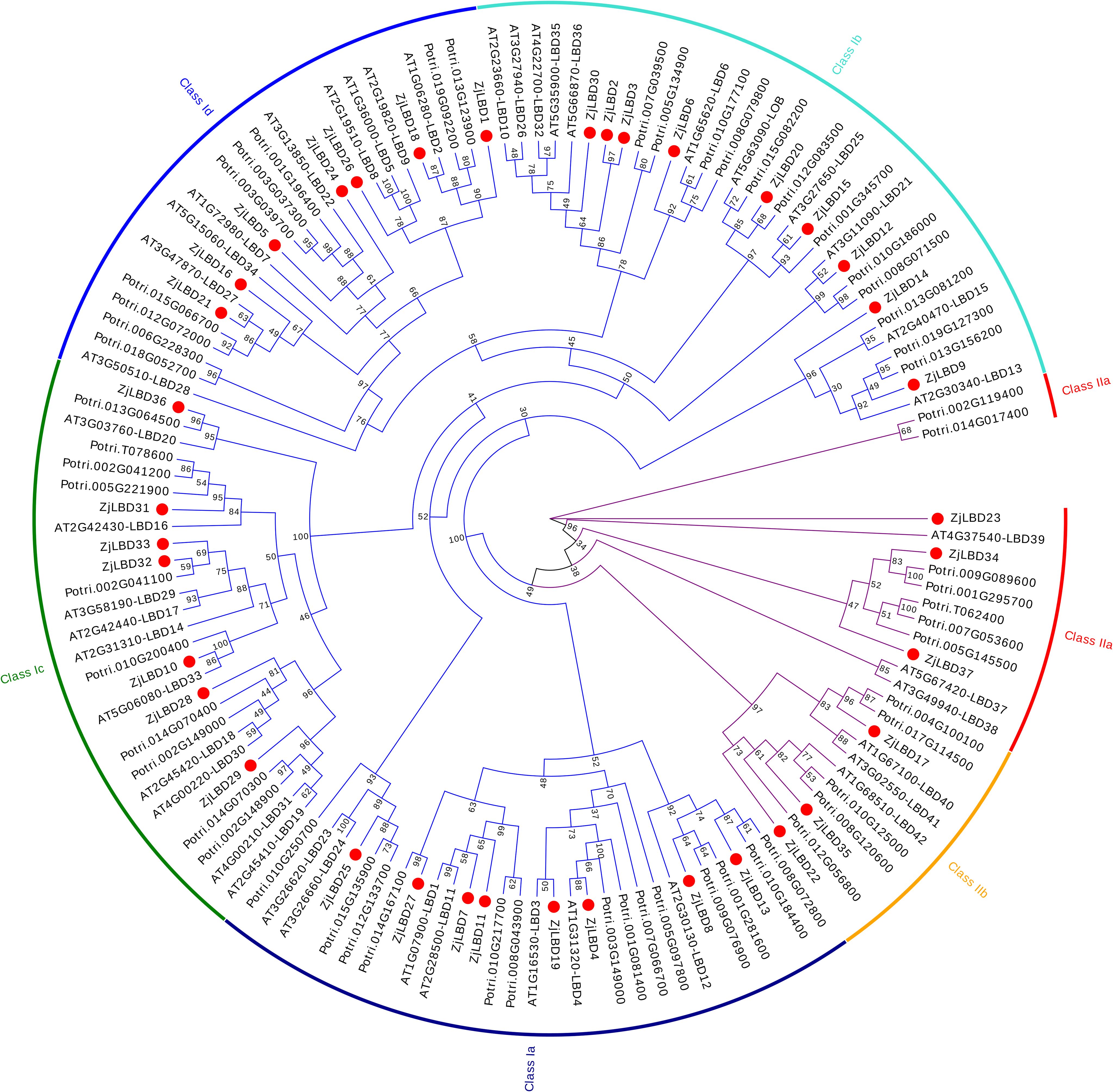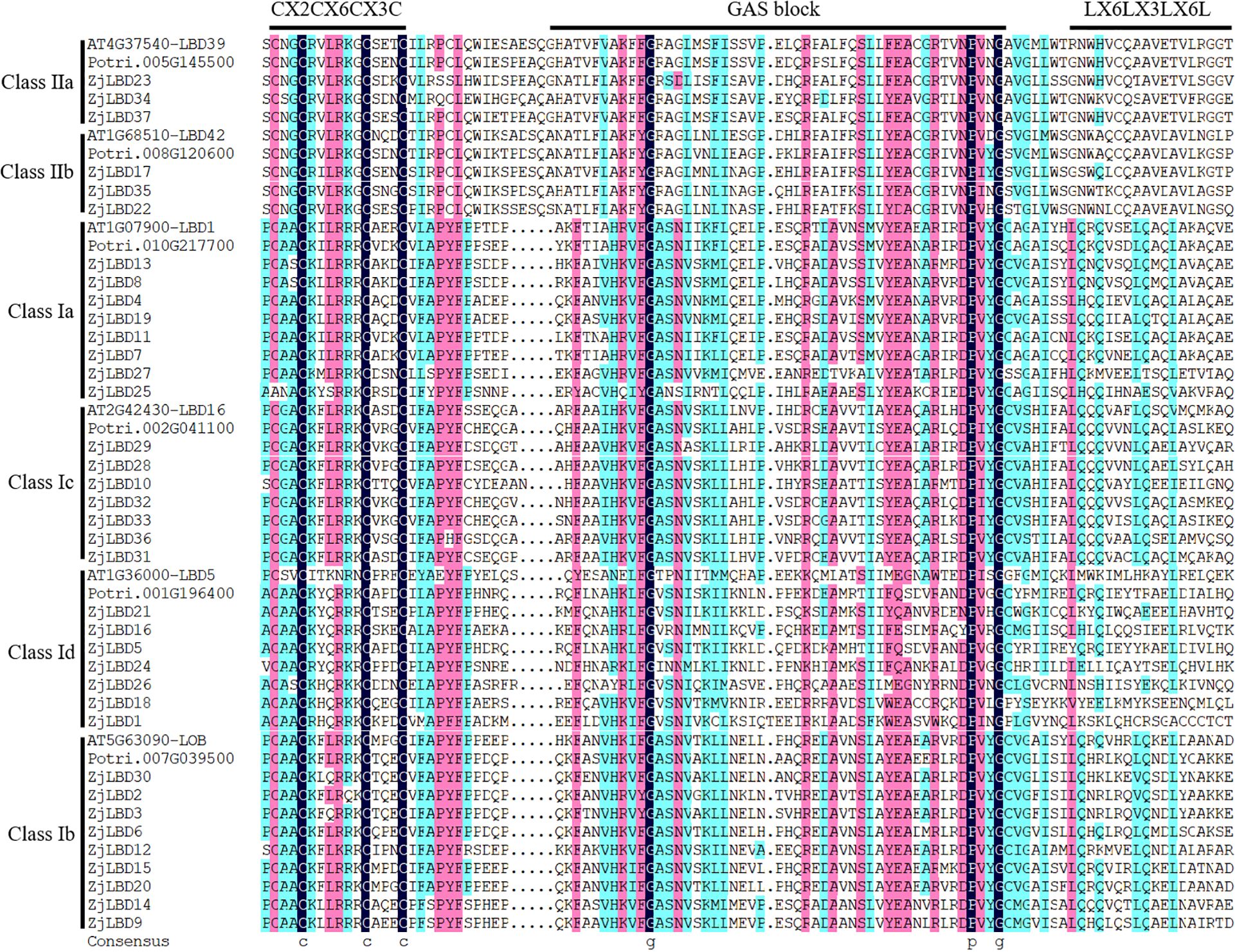- 1Shandong Provincial Key Laboratory of Water and Soil Conservation and Environmental Protection, College of Resources and Environment, Linyi University, Linyi, Shandong, China
- 2Shandong Provincial Forestry Protection and Development Service Center, Department of Natural Resources of Shandong Province, Jinan, Shandong, China
The plant-specific Lateral Organ Boundaries Domain (LBD) transcription factors (TFs) are critical regulators of the expression of genes related to tissue development and stress responses. Sour jujube (Ziziphus jujuba var. spinosa), a stress-tolerant rootstock for jujube cultivation, remains understudied in terms of its LBD gene family. In this study, a genome-wide analysis of the sour jujube genome was performed and 37 ZjLBD genes were identified. These genes were phylogenetically classified into two classes and six subgroups based on evolutionary relationships with Arabidopsis and poplar. These genes were unevenly distributed across 11 chromosomes, with 15 segmental duplication events detected. Upstream TFs of ZjLBDs were predicted and grouped into six interactive networks, revealing that the functions of ZjLBDs may be enriched in stress response, hormone signaling, and tissue development. RNA-seq data demonstrated tissue-specific expression patterns of ZjLBDs, with limited genes highly expressed in fruit. The ZjLBD23 may regulate the development of flowers and white mature fruits, while ZjLBD11, ZjLBD13, ZjLBD22 and ZjLBD28 may be involved in lateral root formation. Analysis of the cis-acting elements, homology relationships and abiotic stress-induced expression levels suggested functional divergence: ZjLBD13, ZjLBD19 and ZjLBD28 may contribute to extreme cold resistance, ZjLBD11, ZjLBD14, ZjLBD33 and ZjLBD35 may be associated with drought tolerance, and ZjLBD9, ZjLBD13 and ZjLBD22 with salt stress adaptation. This study provides critical insights into the biological roles of ZjLBDs and lays a foundation for breeding sour jujube varieties with enhanced stress resilience.
Introduction
Global climate change has precipitated a surge in extreme weather events, subjecting plants to unprecedented challenges from drought, salinity, and freezing stresses. To survive under these adverse conditions, plants deploy intricate physiological and molecular adaptations. Central to these adaptive strategies are the molecular mechanisms governing stress perception, signal transduction, and transcriptional reprogramming—processes critically orchestrated by transcription factors (TFs), for example WRKY, NAC and bZIP, that regulate stress-responsive gene networks (Zhang et al., 2022). These proteins typically possess DNA-binding domains that enable sequence-specific interactions with cis-acting elements in promoter regions, thereby modulating transcriptional activity. Among plant-specific TF families, the Lateral Organ Boundaries Domain (LBD) proteins, also termed ASymmetric Leaves 2-like (ASL), stand out as unique regulators exclusive to higher plants. Characterized by their conserved LOB domain, LBD TFs coordinate diverse developmental processes and stress adaptation mechanisms, ranging from organ morphogenesis to abiotic stress responses (Husbands et al., 2007; Majer and Hochholdinger, 2011).
Since the initial identification of 42 LBD genes in Arabidopsis thaliana (Shuai et al., 2002), numerous plant genome have been sequenced, revealing the presence of LBD TF family members in various species. These include 47 LBDs in tomato (Gupta and Gupta, 2021); 58 in apple (Wang et al., 2013); 40 in grape (Cao et al., 2016) and 57 in poplar (Zhu et al., 2007). Characterized by three structural domains extending from the N- to C-terminus, LBD TFs feature a zinc finger-like C-block (CX2CX6CX3C) for DNA binding, a Gly-Ala-Ser block (GAS block) associated with key LBD functions, and a leucine-like zipper module (LX6LX3LX6L). These domains collectively enable LBD TFs to regulate diverse biological processes, including plant organ development (roots, shoot meristems, leaves, flowers, and embryos), tissue regeneration, nitrogen metabolism, hormonal signaling, and stress responses (Fan et al., 2012).
LBD TFs exhibit functional conservation in regulating root development across diverse plant species (Omary et al., 2022). For instance, the TFs WOX11 and LBD16, in conjunction with the histone demethylase JMJ706, collectively orchestrate the development of crown roots in rice (Geng et al., 2024). Similarly, AtLBD16 and AtLBD29 have been identified as key regulators of lateral root formation (Okushima et al., 2007). Beyond root development, LBDs play pivotal roles in various plant tissues. AtLBD6 controls the stem meristem (Uchida et al., 2007), specifies leaf adaxial identity (Xu et al., 2003), and influences sepal and petal development (Xu et al., 2008). AtLBD30 is implicated in embryogenesis and flower development (Borghi et al., 2007; Soyano et al., 2008). In poplar, PtaLBD1 regulates secondary phloem development (Yordanov et al., 2010), while the ectopic expression of EgLBD37 and EgLBD29 promotes the differentiation of secondary xylem and the production of phloem fibers (Lu et al., 2018). In addition, LBD TFs also feature prominently in nitrogen metabolism, hormone signaling, and stress tolerance. Studies have shown that Arabidopsis thaliana LBD37/38/39 and Malus domestica MdLBD13 negatively regulate anthocyanin biosynthesis, and nitrogen uptake and assimilation (Rubin et al., 2009; Li et al., 2017). Furthermore, the downstream LBD genes of auxin response factors, namely LBD16, LBD17, LBD18, and LBD29, are rapidly activated by callus-inducing medium and the ectopic expression of these genes can autonomously induce callus formation without exogenous hormones (Fan et al., 2012). AtLBD1/3/4/11 in Arabidopsis thaliana mediates the balance of cytokinin-induced secondary growth (Ye et al., 2021). In contrast, the Class II LBD gene family member ZmLBD5 in maize negatively regulates the production of abscisic acid (ABA) and gibberellins, thereby impacting drought tolerance (Feng et al., 2022). Furthermore, the overexpression of VvLBD39 reduces the tolerance of grape to drought and salt stress by regulating stomatal closure, promoting transpiration, and decreasing the capacity for reactive oxygen species scavenging (Chen et al., 2024); whereas the ZAT6-LBD16 transcriptional module regulates lateral root development under salt stress by promoting downstream cell wall remodeling, which could benefit plant adaptation to salt stress (Zhang et al., 2024).
The sour jujube (Ziziphus jujuba var. spinosa), believed to be the ancestor of common jujube, is valued for its health-promoting properties. Its leaves are used for crafting tea, and jujuboside extracted from its seeds is a crucial component in functional beverages, and insomnia treatments. Meanwhile, the sour jujube is distinguished by its extensive and deep root system, which confers remarkable drought tolerance and the ability to thrive in nutrient-poor soils. These characteristics make it an ideal candidate for cultivation in barren mountains. With over 900 varieties of jujube, the resistance of the tree to various stresses largely depends on the rootstock used. Sour jujube is commonly used as the rootstock for jujube trees due to its remarkable tolerance to drought and poor soils (Liu et al., 2020b). Previous studies have identified an autotetraploid sour jujube and shown that its unique xylem morphology contributes to its exceptional drought tolerance. Notably, several LBD genes were identified in the downstream screening for xylem development-related ZjVND7 (Li et al., 2021, 2022). However, the roles of these LBD genes under abiotic stress remain unclear. In this study, LBD genes in sour jujube will be identified, and their gene structure, protein motif structure, cis-acting elements in promoters, chromosomal localization, and the phylogenetic relationships will be analyzed. Additionally, RNA-seq and quantitative real-time PCR (qRT-PCR) analysis will elucidate the expression patterns of these genes during tissue development and under abiotic stresses such as high salinity, drought, and low temperatures. This research is anticipated to elucidate the functional roles of the LBD gene family in sour jujube and establish a foundation for comprehending the mechanisms underlying organogenesis and stress responses.
Materials and methods
Identification of LBD genes in sour jujube
The LBD gene family members in sour jujube were identified using two methods. Initially, 43 LBD genes from Arabidopsis thaliana and 57 LBD genes from poplar were downloaded from the Arabidopsis Information Resource (TAIR, http://www.Arabidopsis.org/) and the Phytozome database (http://rice.plantbiology.msu.edu/), respectively. A blastp search (E < 1 × 10-5) was conducted against the Telomere-to-Telomere (T2T) genome of sour jujube (Li et al., 2024) using the 43 Arabidopsis LBD genes as queries. Subsequently, the Hidden Markov Model (HMM) file for the LOB domain (PF03195) was downloaded from the Pfam database (http://pfam.sanger.ac.uk/), and the sour jujube LBD protein sequences were obtained using the HMMER program (version 3.2.1). The program was run with default settings and a cutoff value of 10-5. Finally, an intersection of the LBD proteins identified by both methods was taken, retaining only those protein sequences encoded by the longest transcripts of the same gene. The LOB domain in ZjLBDs were verified using InterPro (http://www.ebi.ac.uk/interpro/) and SMART (http://smart.embl-heidelberg.de/) according to Letunic et al. (2012).
The domain, phylogeny, and classification analysis of LBD in sour jujube
Six AtLBD and six PtLBD sequences were selected as reference sequences from different subgroups. The full-length LBD protein sequences in sour jujube were aligned using DNAMAN (version 6.0) to delineate the LOB domain. A phylogenetic tree was constructed using the neighbor-joining method with 1000 replicates in MEGA (version X). Based on phylogenetic relationships, the LBD proteins in sour jujube were categorized into distinct classes and subgroups, following the classification methods of AtLBD (Shuai et al., 2002) and PtLBD (Zhu et al., 2007).
Properties and structural analysis of LBD proteins in sour jujube
The open reading frame (ORF) length, molecular weight (MW), and isoelectric point (pI) of LBD proteins in sour jujube were calculated using the ExPASy website (http://web.expasy.org/protparam/). The conserved motifs of LBD proteins in sour jujube were identified using MEME (version 5.1.0, http://meme-suite.org/tools/meme), with the maximum number of motifs set to 20 (Bailey et al., 2009).
Chromosome localization and gene structure analysis of ZjLBDs
The chromosomal localization of ZjLBD genes was determined using MapInspect (http://www.softsea.com/review/MapInspect.html) and aligned to the genomic chromosomes. The selective pressure on ZjLBD genes was assessed through Ka/Ks ratios. The exon-intron structure of ZjLBD genes was predicted by comparing the coding sequence (CDS) with their corresponding full-length DNA sequences using the Gene Structure Display Server (http://gsds.cbi.pku.edu.cn) (Hu et al., 2015). Visualization was performed using TBtools (version 1.0) (Chen et al., 2020).
Analysis of cis-regulatory elements in the ZjLBDs promoters
A 2.0-kb sequence upstream of the transcription start site of ZjLBD was extracted from the sour jujube genome and submitted to the PlantCARE website (http://bioinformatics.psb.ugent.be/webtools/plantcare/html/) to identify cis-regulatory elements involved in hormone signaling, defense and stress responses, and growth and development regulation (Lescot et al., 2002).
Regulatory network and GO enrichment analysis of ZjLBDs and its upstream transcription factors
To identify the potential TF genes binding with ZjLBDs promoters, the promoter sequences of ZjLBDs were retrieved. Following the method described by Tian et al. (2020), the binding site prediction tool available on the PlantRegMap platform (https://plantregmap.gao-lab.org/index.php) we utilized to scan for TF binding sites with a threshold p-value ≤ 1e-4. The potential TF genes identified through this process were further subjected to Gene Ontology (GO) enrichment analysis. GO terms with a p-value < 0.01 were selected as significantly enriched terms.
Expression patterns of ZjLBDs in diverse tissues
To investigate the expression patterns of ZjLBD genes across various tissues, RNA-seq datasets from 9 distinct tissue types—namely root, leaves, flower, stem, branch, young fruit, white mature fruit, half-red fruit, and fully red fruit—were retrieved from the National Center for Biotechnology Information (NCBI) database under Sequence Read Archive (SRP046073) (Liu et al., 2014). After filtering the raw data, SRA files were converted to FASTQ format through SRA Toolkit (version 2.8.2). Quantitative gene expression analysis was conducted using Cufflinks (version 2.2.1) on the aligned read files, with gene expression levels being determined based on the Fragments Per Kilobase per Million mapped reads (FPKM).
Plant materials and stress treatments
To further confirm the differential expression levels of ZjLBD genes identified in RNA-seq in different tissues, samples of root, leaves, flower, stem, branch, and fruit were collected from three ‘Dongzao’ jujube trees for experiments in 2024.
To analyze the expression levels of ZjLBD genes under abiotic stresses, 45-day-old rooted sour jujube seedlings were transferred to Hoagland nutrient solution for 1 week and then subjected to simulated drought and salt conditions. For drought treatment, seedlings were placed in a 20% PEG6000 solution, and leaves were collected after 6 h, 12 h, and 48 h of treatment. For salt treatment, seedlings were placed in Hoagland nutrient solution containing 150 mmol/L NaCl, and leaves were collected after 24 h and 48 h of treatment. Untreated seedlings served as control group for both drought and salt treatments.
For cold stress, branches with consistent growth vigor were selected from three Dongzao jujube trees. These branches were then exposed to temperatures of 4 °C, -10°C, -20°C, -30°C, and -40°C for 10 h at a cooling rate of 5 °C/h, and the branches treated at 4 °C were used as control samples. Then the xylem of branches was collected.
All experiments were conducted with three biological replicates. After collection, samples were flash-frozen in liquid nitrogen and stored at -80°C for qRT-PCR analysis.
RNA extraction and qRT-PCR analysis
RNA extraction was performed using the Aidlab RNA Extraction Kit (Aidlab Biotechnologies Co., Ltd, Beijing, China). Following quantification and integrity assessment of the extracted RNA, qRT-PCR analysis was conducted using a Roche Light Cycler 96 instrument with the 2-ΔΔCt method (Livak and Schmittgen, 2001). The primers used are listed in Supplementary Table 1.
Results
Identification, location and property analysis of ZjLBD genes
A combination of two bioinformatics approaches was employed to identify members of the LBD gene family in sour jujube. Initially, we performed a BLASTP search using 43 LBD TFs from Arabidopsis thaliana as queries, identifying 38 candidate LBD proteins in sour jujube. Subsequently, we utilized a HMM based on the LOB domain (Pfam PF03195) to identify 38 LBD proteins. By intersecting the results from both methods and removing redundant sequences, we ultimately identified 37 unique LBD genes for further analysis (Table 1).
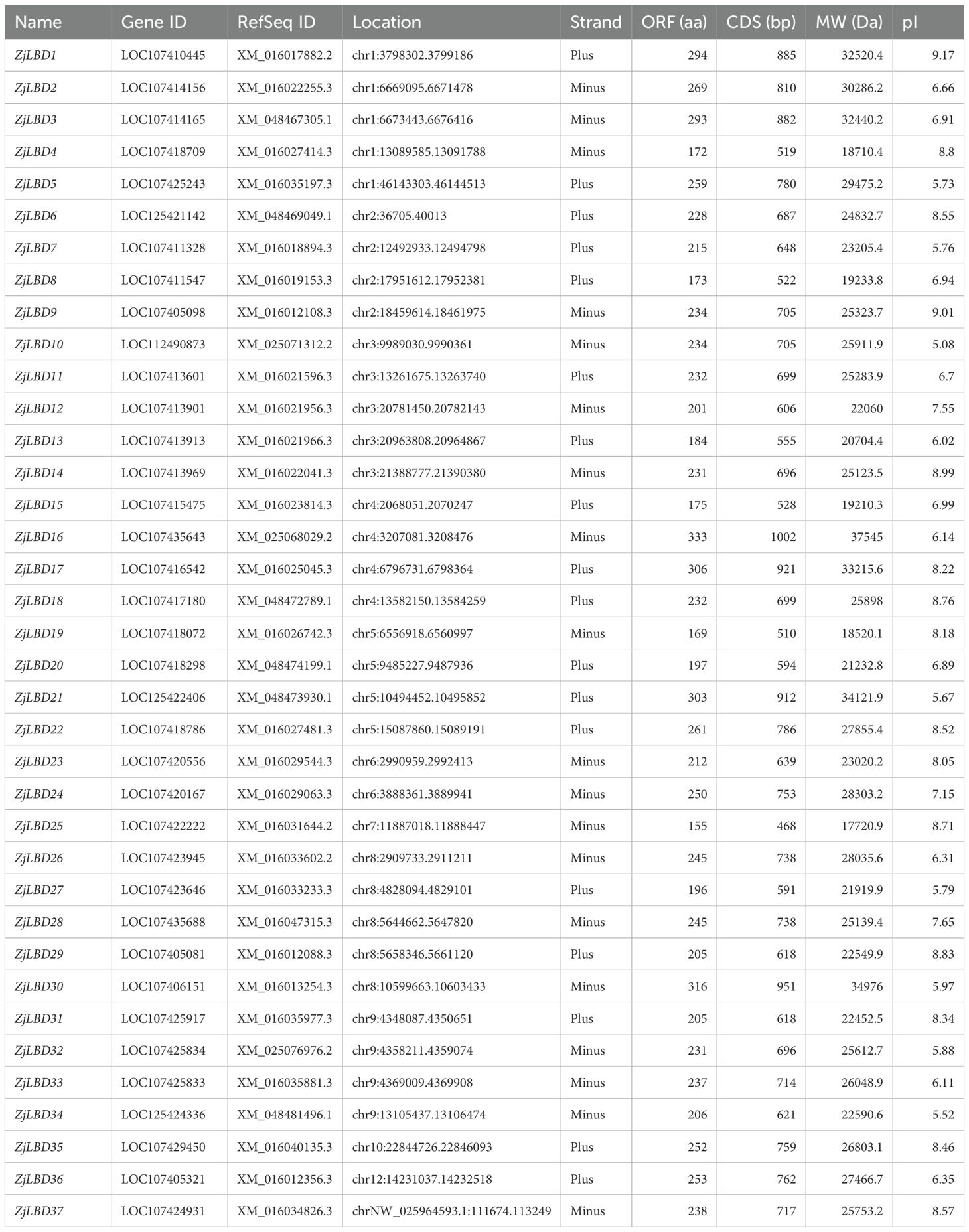
Table 1. Identification, localization and property analysis of ZjLBD genes and ZjLBD proteins in sour jujube.
Based on the positional information of LBD genes on chromosomes, the 37 LBD genes were designated as ZjLBD1-ZjLBD37. A comprehensive analysis was conducted on these genes and their encoded proteins, encompassing gene location, ORF length, CDS length, MW, and pI. As shown in Table 1 and Figure 1, ZjLBDs are distributed across 11 chromosomes. The CDS lengths range from 468 bp (ZjLBD25) to 1002 bp (ZjLBD16), while the ORF lengths of the LBD proteins vary from 155 amino acids (ZjLBD25) to 333 amino acids (ZjLBD16). The MW of the proteins span from 17.72 kDa (ZjLBD25) to 37.55 kDa (ZjLBD16), and the predicted pI range from 5.08 (ZjLBD10) to 9.17 (ZjLBD1).
Fifteen homologous gene pairs were detected among nine chromosomes in the ZjLBDs, representing inter-chromosomal collinearity events. Notably, ZjLBD23 located on Chr6 and ZjLBD34 on Chr9 were identified as high-frequency genes for collinearity events, each occurring three times.
To assess the selective pressure on these colinear ZjLBD genes during the evolutionary process, the ratio of the number of nonsynonymous substitutions per nonsynonymous site (Ka) to the number of synonymous substitutions per synonymous site was analyzed (Supplementary Table 2). The results indicated that for 13 colinear events involving 19 ZjLBD genes, 11 pairs of ZjLBD genes exhibited Ka/Ks ratios less than 1, suggesting that these genes were under purifying selection.
Phylogenetic analysis and domain recognition of ZjLBD family proteins
A phylogenetic analysis was conducted on 43 Arabidopsis and 57 poplar LBD proteins along with the LBD family proteins of sour jujube (Figure 2). These proteins were classified into two major groups, Class I and Class II, which were further divided into four (subgroups Ia to Id) and two subgroups (subgroups IIa to IIb), respectively. Class I contained 31 ZjLBD proteins, while Class II included only 6. Similarly, the number of LBD proteins in Arabidopsis and poplar was higher in Class I than in Class II.
Six AtLBD proteins (AT4G37540-LBD39, AT1G68510-LBD42, AT1G07900-LBD1, AT2G42430-LBD16, AT1G36000-LBD5, AT5G63090-LOB) and six PtLBD proteins (Potri.005G145500, Potri.008G120600, Potri.010G217700, Potri.002G041100, Potri.001G196400, Potri.007G039500) were randomly selected from the six subgroups. Their LOB domains were used as references to identify the domains in ZjLBDs. As shown in Figure 3, all 37 ZjLBD proteins possess a conserved N-terminal motif composed of cysteine residues (CX2CX6CX3C) indicating their DNA-binding capabilities. The C-terminus of Class I contains a leucine zipper-like motif (LX6LX3LX6L), which is associated with protein dimerization. Additionally, subgroups Ia, Ib, and Ic contain a conserved glycine-alanine-serine (GAS) domain near the C-terminus, which includes conserved proline and glycine residues.
Analysis of ZjLBDs encoding protein motif and gene structure
Structural analysis of the ZjLBD genes and their encoded proteins revealed distinct motif compositions and gene structures. As depicted in Figures 4A, B, ZjLBD proteins contain 10 motifs, with motif 1 and motif 2 consistently present at the N-terminus. Class I and Class II proteins exhibit different motif compositions, with motif 3 being unique to Class II. Notably, all Class I proteins, except for ZjLBD1 and ZjLBD18, contain motif 6. Additionally, unique motifs (motifs 5, 7, 8, 9, and 10) are found in only 2 to 6 ZjLBD proteins within Class I, suggesting that these proteins may have distinct functions.
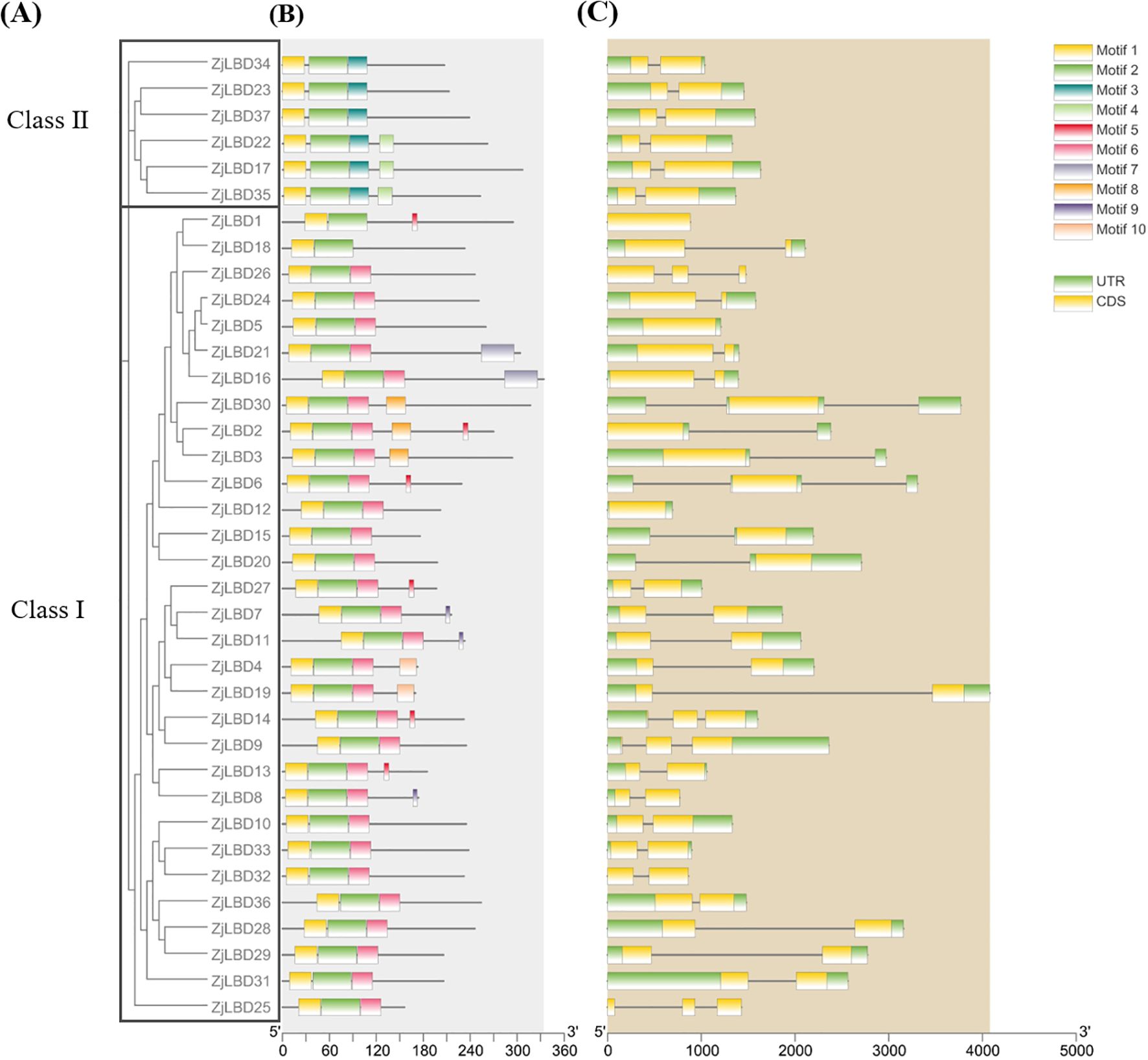
Figure 4. Phylogeny (A), putative motif analysis (B), and gene structure (C) of each ZjLBD protein and ZjLBD gene. Exon and intron are represented by yellow boxes and grey lines, respectively. Lengths of exons and introns of ZjLBDs are displayed proportionally.
The coding and non-coding regions of the ZjLBD genes were also analyzed. The lengths of all ZjLBD genes were within 4500bp, with the numbers of coding region varying from one (ZjLBD1, ZjLBD2, ZjLBD3, ZjLBD5, ZjLBD6, ZjLBD12, ZjLBD15, ZjLBD20, ZjLBD30) to three (ZjLBD25, ZjLBD26). As shown in Figure 4C, the structures of Class I and Class II genes were distinctly different, with more than half of the ZjLBD genes in Class I exhibiting longer intron sequences compared to those in Class II.
Analysis of cis-acting elements in the promoters of ZjLBD genes
A total of 100 types of cis-acting elements were detected in the ZjLBDs promoters, including 8 unnamed elements, which were annotated as having 43 functions. The TATA-box was the most frequently detected element, present in all ZjLBDs promoters. For further analysis, 14 types of functional annotations were selected. As shown in Figure 5, the anaerobic induction element (ARE) and the abscisic acid response element (ABRE) were present in all ZjLBDs. Specifically, 8, 7, and 6 ABREs were found in the promoters of ZjLBD28, ZjLBD29, and ZjLBD35, respectively. At least one of the five hormone response elements was present in each ZjLBD promoter, and eight methyl jasmonate responsiveness elements have been identified in the promoter of ZjLBD11. Notably, drought induction element coexisted with ABRE in 14 ZjLBDs promoters. Of the 13 ZjLBDs promoters containing auxin response elements, four types were identified: AuxRR-core, TGA-element, TGA-box, and AuxRE. Except for ZjLBD5 and ZjLBD12, all of these ZjLBDs promoters co-occur with elements annotated in growth-related pathways. The promoters of 24 ZjLBDs contain 6 types of development-related elements associated with cell cycle regulation, seed-specific expression, meristem and endosperm development, and circadian rhythm control, with meristem expression-related element identified in 11 of these promoters. Additionally, 9 types of site-binding elements were identified in the ZjLBDs promoters, among which the MYB binding site involved in drought-inducibility, was the most common. These findings suggest that ZjLBD genes promoters harbor cis-acting elements associated with hormone responsiveness, stress induction, and growth-related functions, highlighting their potential roles in stress adaptation and developmental regulation.
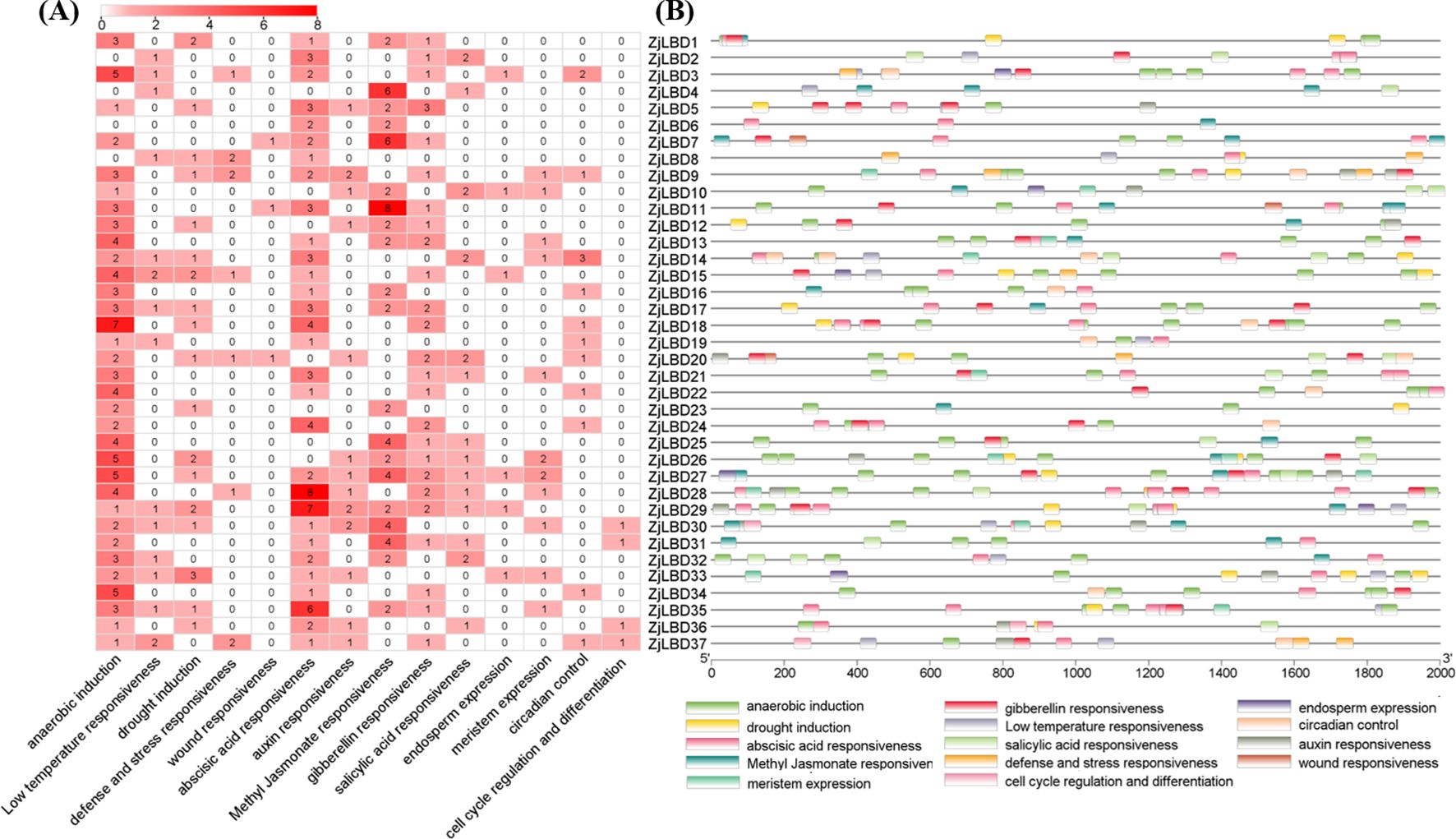
Figure 5. The number (A) and distribution (B) of cis-acting elements in the promoters of ZjLBD genes.
Upstream TFs of ZjLBDs associated with stress responses and tissue development
We conducted a comprehensive analysis of transcriptional regulatory sites in the promoters of ZjLBDs, and identified 350 potential upstream genes encoding 39 types of TFs that collectively have 11,261 binding sites across the promoter sequences of 37 ZjLBDs. Among these ZjLBDs, the promoter of ZjLBD36 was predicted to possess the highest number of TF binding sites, totaling 516, and it may interact with 166 upstream TF genes. The Dof has the most binding sites with the ZjLBDs promoters. Additionally, the highest numbers of genes encoding ERF and MYB were predicted, with 44 and 41 genes, respectively. As shown in Figures 6A–F, the interaction regulatory network analysis of upstream TF binding to the promoters of ZjLBDs in six subgroups revealed that subgroup Ia is centered around ZjLBD19, which is likely regulated by 87 genes encoding TFs. Subgroup Ib includes ZjLBD14 and ZjLBD30, which may be regulated by 103 and 112 TF genes, respectively. Subgroup Ic is represented by ZjLBD29, regulated by 187 TF genes, while subgroup Id is represented by ZjLBD26, regulated by 172 TF genes. Subgroup IIa is centered around ZjLBD34, regulated by 147 TF genes, and subgroup IIb is centered around ZjLBD17, regulated by 189 TF genes. These findings reveal the intricate and diverse transcriptional regulatory modules of ZjLBDs across different subgroups, providing a basis for elucidating their functional divergence.
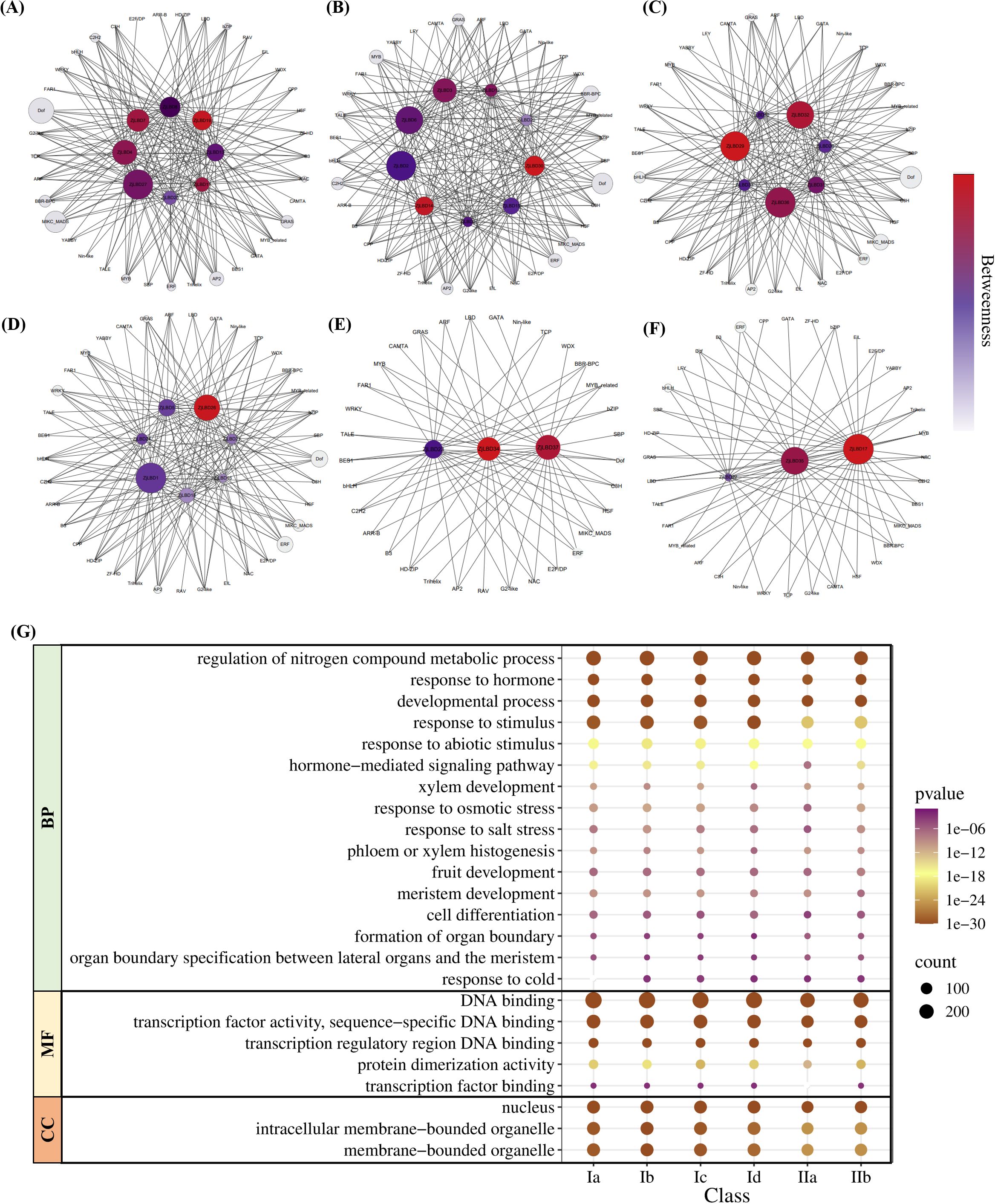
Figure 6. Regulatory network and GO enrichment analysis of ZjLBDs and its upstream transcription factors. (A-F) Regulatory network of ZjLBDs and its potential upstream TFs in subgroups Ia (A), Ib (B), Ic (C), Id (D), IIa (E), IIb (F). (G) GO enrichment analysis of potential upstream TFs genes of ZjLBDs in six subgroups.
The TF genes potentially binding to the ZjLBDs promoters were subjected to Gene Ontology (GO) enrichment analysis, revealing that 342 TF genes were enriched in 415 GO terms (Figure 6G). The GO enrichment analysis indicated that the upstream TF genes of ZjLBDs in each subgroup were significantly enriched in the Biological Process (BP) terms regulation of nitrogen compound metabolic process and response to stimulus. Notably, the enriched p-values for response to stimulus and response to abiotic stimulus in the upstream TF genes of ZjLBD genes in Class II were higher than those in Class I. Meanwhile, the annotation count of upstream TF genes in response to osmotic stress and response to salt stress was lower in Class II than in Class I, yet the number remains greater than 18. Except for subgroup Ia, which lacked upstream gene annotations for response to cold, all other subgroups had more than 10 genes annotated in this pathway. Additionally, approximately 10 genes were annotated in pathways related to xylem development and phloem or xylem histogenesis. Five subgroups on average possess 27, 19 and 4 upstream TF genes annotated in fruit development, meristem development, and formation of organ boundary. In the Molecular Function (MF) category, the most abundant term was DNA binding. Significant differences were observed between Class I and II in terms of protein dimerization activity and specific DNA-binding functions. Specifically, subgroup IIa has more than 40 fewer genes annotated in transcription factor activity, sequence-specific DNA binding compared to Class I, and no genes were annotated in transcription factor binding. Finally, no significant differences were observed in the Cellular Component (CC) annotations of the potential upstream genes across the six subgroups. Therefore, although the upstream TF genes of ZjLBDs in different subgroups exhibit similar functions, these factors form modules that may exhibit hierarchical or intensity-dependent characteristics in tissue development and stress adaptation.
Expression patterns of ZjLBDs in various tissues
Based on publicly available RNA-seq data, the expression levels of ZjLBD genes were analyzed across six different tissues: root, leaves, flower, stem, branch and fruit (Figure 7A). The results revealed that different ZjLBDs showed distinct expression patterns across various plant tissues. Notably, 11 ZjLBD genes from subgroups Ia, Ib, Id, and IIa exhibited higher expression levels in flowers compared to other tissues. The root tissue contained 7 highly expressed ZjLBD genes, including ZjLBD7 (subgroup Ia) and ZjLBD22 (subgroup IIb), whose expression levels were 312-fold (for semi-red fruits) and 16-fold (for fully red fruits) higher than those in the least expressing tissue, respectively. Furthermore, ZjLBD12 and ZjLBD23 were highly expressed in flowers, whereas ZjLBD15 was predominantly expressed in stems, and ZjLBD19 and ZjLBD37 were highly expressed in branches. Notably, there was almost no high expression of ZjLBD genes in leaves. The expression levels of ZjLBD genes in jujube fruits were generally low, with only 6 ZjLBD genes exhibiting FPKM values exceeding 20. When comparing the expression of ZjLBD genes across four developmental stages of fruit, 8 ZjLBD genes from five subgroups showed elevated expression during the white mature stage. These ZjLBD genes included members from subgroup IIb, as well as ZjLBD11 (subgroup Ia) and ZjLBD37 (subgroup IIa).
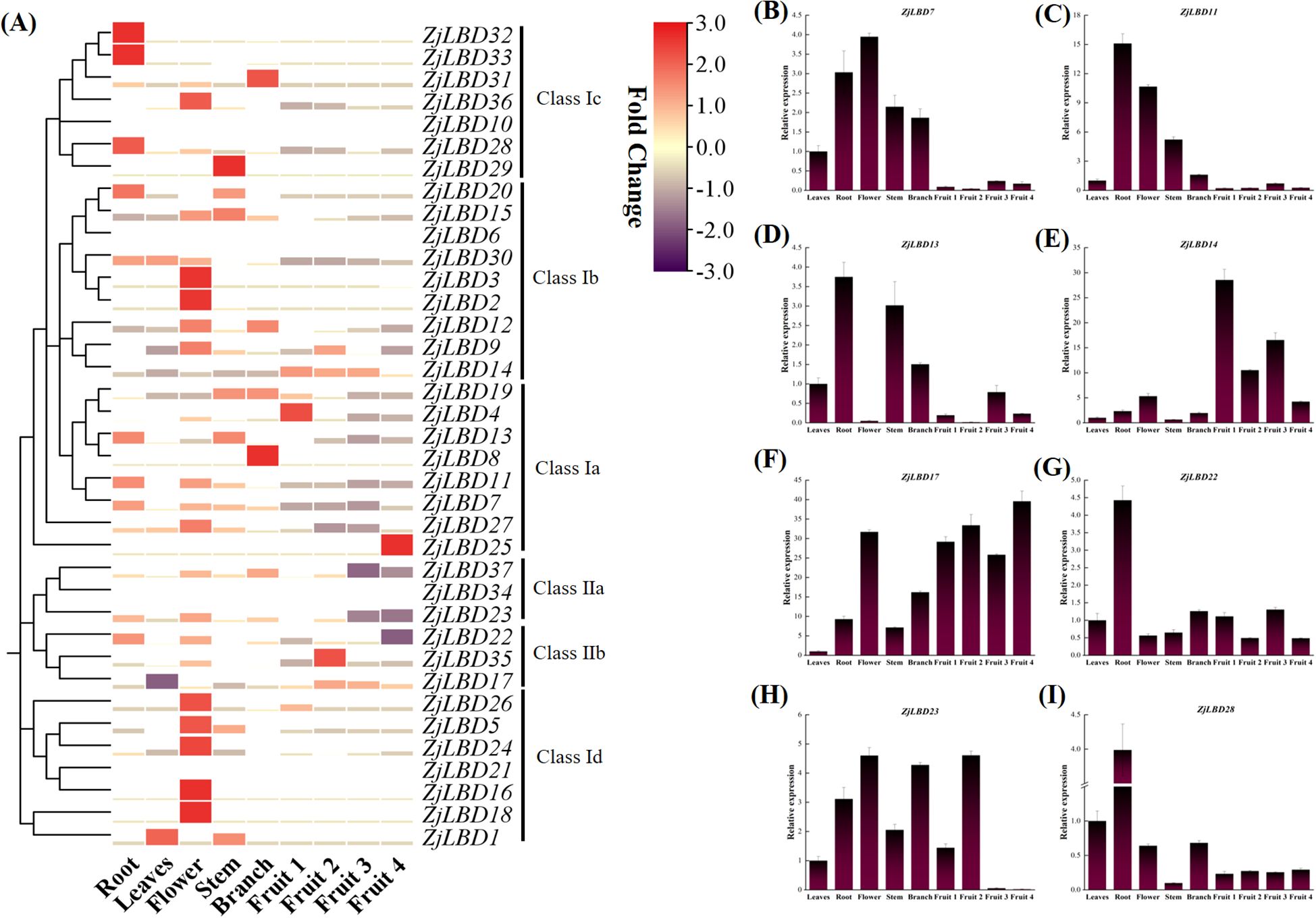
Figure 7. Expression pattern of ZjLBD genes in root, leaves, flower, stem, branch and fruit of sour jujube. (A) Expression patterns of ZjLBDs from RNA-seq data. The height of the bars represents the fold change of gene expression. (B-I) qRT-PCR analysis of selected differentially expressed ZjLBD genes, including ZjLBD7 (B), ZjLBD11 (C), ZjLBD13 (D), ZjLBD14 (E), ZjLBD17 (F), ZjLBD22 (G), ZjLBD23 (H) and ZjLBD28 (I). Fruit 1: Young fruit, Fruit 2: White mature fruit, Fruit 3: Semi-red fruit, Fruit 4: Fully red fruit.
To validate the expression levels of these genes across different tissues, ZjLBD7, ZjLBD11, ZjLBD13, ZjLBD14, ZjLBD17, ZjLBD22, ZjLBD23 and ZjLBD28 were further selected for qRT-PCR analysis (Figures 7B–I). The expression level of ZjLBD17 was significantly lower in leaves, while it was relatively higher in fruits. In contrast, ZjLBD7 and ZjLBD11 exhibited lower expression levels in fruits compared to in other tissues. Notably, ZjLBD11, ZjLBD13, ZjLBD22, and ZjLBD28 had higher expression levels in roots, while ZjLBD7 and ZjLBD23 were more highly expressed in flowers. During the four developmental stages of fruit development, ZjLBD14 showed a higher expression level in young fruit, where it reached the highest expression, with the maximum fold change being 45 times higher than that in stems. Meanwhile, ZjLBD13, ZjLBD14, and ZjLBD23 exhibited distinct differential expression patterns. Specifically, ZjLBD13 and ZjLBD14 showed a pattern of initial decrease, followed by an increase, and then a decrease again, while ZjLBD23 demonstrated a pattern of initial increase followed by a sharp decline, with its expression level dropping 84-fold from the white mature stage to the semi-red stage. The expression patterns of these genes in different tissues reveal their potential roles in the development of specific tissues.
Expression patterns of ZjLBDs under low temperature, drought, and salt stress
Based on the analysis of promoter and upstream transcription factor functions, 12 ZjLBD genes—ZjLBD9, ZjLBD11, ZjLBD13, ZjLBD14, ZjLBD17, ZjLBD19, ZjLBD22, ZjLBD23, ZjLBD24, ZjLBD28, ZjLBD33 and ZjLBD35—from six subgroups were selected for analysis of their expression levels under three independent stress treatments: low temperature, drought, and salt conditions (Figures 8A–L). The results indicated that, except for ZjLBD14, the other ZjLBD genes exhibited distinct expression patterns under different low-temperature environments. Specifically, ZjLBD22 was down-regulated at -10°C, with a 3.5-fold decrease compared to its expression at 4°C, while ZjLBD9 showed a 6-fold increase at -10°C relative to at 4°C. At -30°C, ZjLBD28 exhibited an approximately 383-fold increase in expression compared to 4°C, whereas ZjLBD13 showed a 9-fold decrease. Furthermore, ZjLBD19 expression was downregulated at -20°C and remained low even at -40°C. Under drought stress, the expression level of ZjLBD14 remains significantly higher for 48 h of drought treatment than that under normal conditions. The expression level of ZjLBD23 significantly decreased by 2-fold within 6 h of drought stress but returned to normal levels thereafter. Meanwhile, the expression of ZjLBD33 was upregulated by 5-fold after 6 h of drought treatment. Additionally, after 48 h of drought treatment, two genes—ZjLBD9 and ZjLBD35—showed significant upregulation compared to the control group, with increases of 3-fold and 4-fold, respectively. Meanwhile, ZjLBD11 exhibited a significant reduction. In response to salt stress, the expression levels of ZjLBD13, ZjLBD22, ZjLBD23, ZjLBD24, ZjLBD28, and ZjLBD35 gradually increased with the duration of salt stress. Notably, after 48 h of salt stress, the expression level of ZjLBD22 was 21-fold that of the control group. Specifically, the expression of ZjLBD9 was approximately halved after 24 h of salt stress compared to the untreated control group. The expression patterns of these genes reveal their regulatory function under different stress conditions, providing important clues for understanding gene functions.
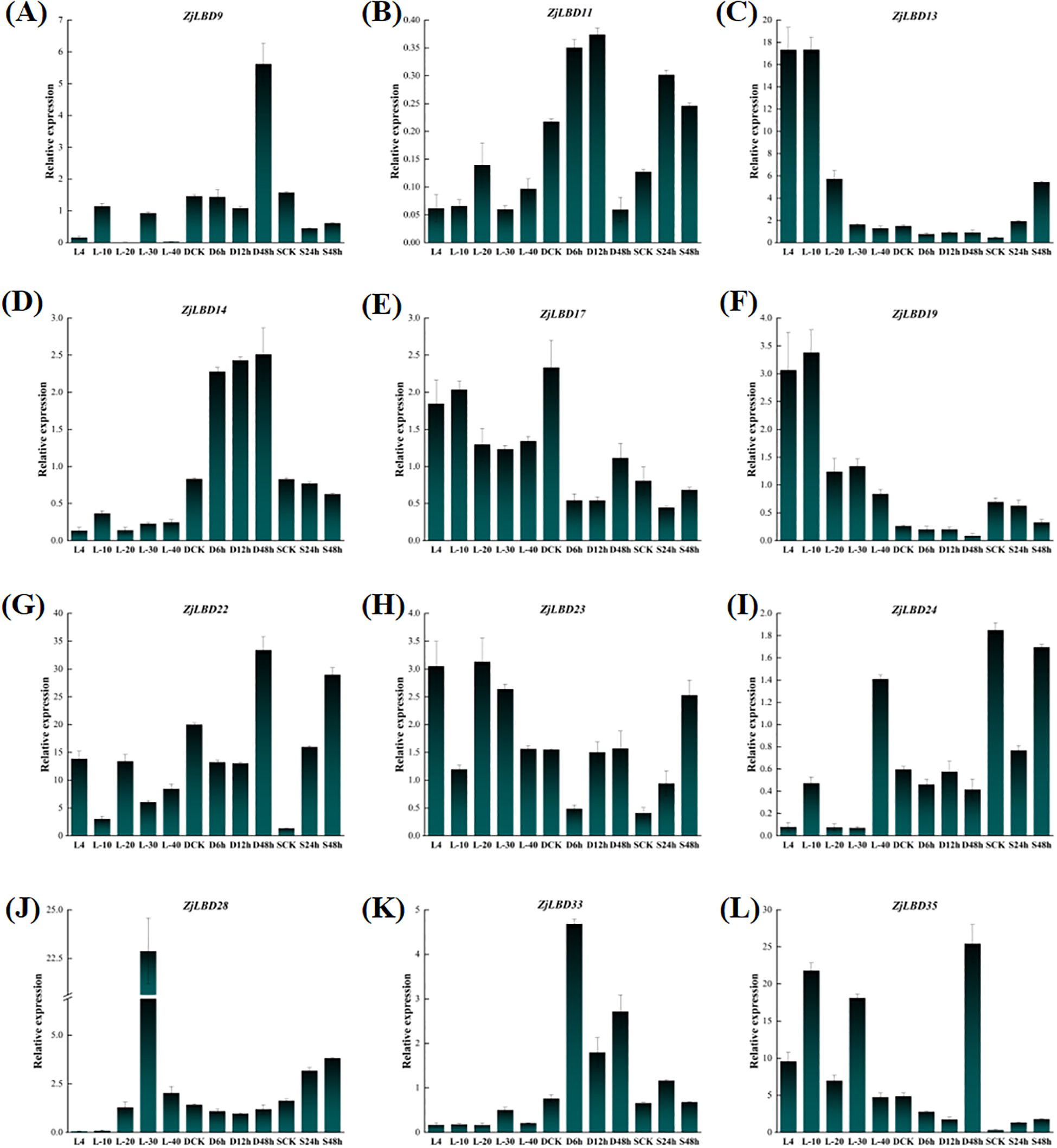
Figure 8. Expression pattern of ZjLBD9 (A), ZjLBD11 (B), ZjLBD13 (C), ZjLBD14 (D), ZjLBD17 (E), ZjLBD19 (F), ZjLBD22 (G), ZjLBD23 (H), ZjLBD24 (I), ZjLBD28 (J), ZjLBD33 (K) and ZjLBD35 (L) under low temperature, drought, and salt stress in sour jujube. L4, L-10, L-20, L-30, and L-40 represent sour jujube branches treated at 4 °C, -10 °C, -20 °C, -30 °C, and -40 °C. D6h, D12h and D48h represent the sour jujube leaves after drought treatment for 6 h, 12 h and 48 h. S24h, S48h represent the sour jujube leaves after 24 h and 48 h of NaCl treatment.
Discussion
The LBD family is integral to the regulation of tissue development as well as responses to environmental stimuli in plants. In sour jujube, we identified 37 ZjLBDs, fewer than the 43 in Arabidopsis thaliana, 58 in apple, and 57 in poplar. This suggests that the ZjLBD family has not experienced significant gene expansion events. The classification of LBD proteins into two major groups and six subgroups, as observed in sour jujube, aligned with patterns seen in Arabidopsis and poplar, indicating a conserved evolutionary origin of LBD gene family across different plant species. Based on the analysis of protein structural domains, the GAS block domain in ZjLBDs contained conserved proline and glycine residues. Lee et al. (2013) demonstrated that the conserved proline residue in the LOB domain of AtLBD18 is critical for DNA binding and biological function and substituting this proline residue with a leucine residue inhibited lateral root growth in Arabidopsis overexpressing AtLBD16 and AtLBD18. These findings suggest the important role of the conserved proline residue in sour jujube. However, the function of the glycine residues remains unclear. The glycine residue, while conserved, may play a structural role in maintaining the stability of the GAS block domain. Motifs usually refer to short sequences involved in important biological processes. The presence of motifs 5–10 only in Class I; and motifs 3 and 4 only in Class II suggests they may have unique biological functions that remain to be determined. Additionally, we identified 15 segmental duplication events and 11 pairs of ZjLBD genes under purifying selection. These findings suggest that these ZjLBD genes may play important roles during evolution. Future studies should investigate the specific roles of these genes in environmental adaptation and their potential applications in breeding programs.
The structure of gene promoters and their regulatory pathways are closely related to many plant traits. The promoters of ZjLBD genes contain a variety of cis-regulatory elements with core physiological functions, suggesting that ZjLBD genes may respond to multiple internal and external environmental signals. Previous studies have shown that the expression of ZjLBD genes in plants is regulated by drought and ABA. For example, the overexpression of PheLBD29 can enhance the drought tolerance of bamboo (Wu et al., 2023); AtLBD14 is involved in ABA-mediated lateral root formation and control in Arabidopsis (Jeon et al., 2017), and ZmLBD5 negatively regulates maize drought tolerance by impairing ABA synthesis (Feng et al., 2022). Drought-inducible elements and ABRE elements coexist in the promoters of 14 ZjLBD genes, which may be involved in ABA-mediated drought stress responses. Furthermore, 11 ZjLBD genes contain both auxin-responsive elements and development-related elements, implying their roles in auxin signal transduction and tissue development. A similar result was found in Medicago truncatula, where MtARF2 binds to the auxin-responsive element in the MtLBD17/29a promoter to control nodulation and root architecture (Kirolinko et al., 2024). Additionally, the gene response to the environment may be closely related to the abundance of functional cis-acting elements. The promoters of ZjLBD genes have the highest number of TATA-box elements, indicating their key role in initiation of transcription (Jores et al., 2021). A study found that SlLBD40, which participates in jasmonic acid signal transduction during drought resistance in tomato, is a negative regulator of drought tolerance (Liu et al., 2020a). The promoter of ZjLBD11 is rich in jasmonic acid response elements, and its expression was significantly downregulated after 48 h of drought stress, indicating that ZjLBD11 may also act as a negative regulator of drought resistance in sour jujube.
A genome-wide study of LBD TFs in sour jujube provides valuable insights into the functions of these genes in specific pathways. Transcriptome data reveal that 11 ZjLBD genes are involved in flower development, while 7 ZjLBD genes are associated with root development. As shown in transgenic Arabidopsis, overexpression of CsLBD37 leads to shorter plants, earlier flowering, and reduced seed production (Teng et al., 2022). LBD13, which is expressed in the meristems of lateral roots and elongated lateral roots, regulates lateral root formation (Cho et al., 2019). These findings suggest that LBDs in the same subgroup (Ib and IIa) in sour jujube may play crucial roles in regulating flowering time and lateral root development. The high expression of ZjLBD23 from subgroup IIa in flowers indicates its potential functional roles during flower development. ZjLBD11, ZjLBD13, ZjLBD22 and ZjLBD28 are highly expressed in roots, indicating their potential involvement in the lateral root formation. Among these, ZjLBD13 is gradually upregulated upon salt stress treatment, indicating that it may play a role in responding to salt stress through lateral root development (Zhang et al., 2024). Eight ZjLBD genes exhibit elevated expression levels during the white mature stage of fruit development. Specifically, the high expression fold of ZjLBD23 at this stage compared to the semi-red stage suggests its role during the development of white mature fruits (Chen et al., 2017).
The potential upstream transcription factors of ZjLBDs were significantly enriched in response to stimuli, including responses to hormones, osmotic stress, and salt stress, suggesting that ZjLBDs may play an important role in environmental stress response. Notably, the functions of 9 AtLBD genes in this subgroup under low-temperature conditions have not been previously reported, and the potential upstream transcription factors of ZjLBDs may also be involved in xylem development, suggesting their potential unique roles in adapting to low-temperature stress in woody plants. ZjLBD19, which was differentially expressed at -20°C, -30°C and -40°C, contains a low-temperature responsive element, indicating its potential involvement in cold tolerance. The expression patterns of ZjLBD13 and ZjLBD28 suggest their responses to extreme low temperatures at -30°C, highlighting their significant functions in the cold tolerance of sour jujube. Under drought stress, ZjLBD33, which contains 3 drought-responsive elements, was differentially expressed. Furthermore, ZjLBD14 and ZjLBD35, containing 3 and 6 ABRE elements, respectively, also showed differential expression after 12 h and 48 h of drought stress, indicating their roles in drought resistance. Under salt stress, both ZjLBD9 and ZjLBD22, which contain ABRE elements, exhibited significant differential expression. Notably, ZjLBD9 also includes 2 stress-responsive elements. These findings suggest that ZjLBD9 and ZjLBD22 may play crucial roles in the response to salt stress. Overall, the differential expression of these ZjLBD genes under various abiotic stress conditions highlights their vital contributions to stress resistance of sour jujube, providing valuable insights into the molecular mechanisms for plant adaptation to adverse environments.
Conclusion
In this study, we identified 37 ZjLBD TFs in sour jujube and classified them into two groups and six subgroups based on their evolutionary relationships. These ZjLBD genes have undergone 15 segmental duplication events, and 13 genes show evidence of purifying selection. All identified proteins contain the conserved CX2CX6CX3C motif, which is essential for DNA binding. Class I proteins feature the LX6LX3LX6L motif, associated with protein dimerization, and subgroups Ia, Ib, and Ic contain the GAS domain, which is crucial for biological functions. Gene structure analysis revealed that ZjLBD genes from different groups have distinct intron lengths and motif sequence types. Promoter and upstream TF prediction analysis suggested that ZjLBD genes promoters may be involved in pathways related to growth and development, stress responses, and hormone signaling. Expression analysis indicated that several ZjLBD genes play roles in flower, root and fruit development. For example, ZjLBD23 may be involved in flower and fruit development during the white mature stage, while ZjLBD11, ZjLBD13, ZjLBD22 and ZjLBD28 may associated with the lateral root formation. These genes also exhibit potential functions under stress conditions. Specifically, ZjLBD13, ZjLBD19 and ZjLBD28 showed differential expression in response to extreme low-temperature conditions, ZjLBD11, ZjLBD14, ZjLBD33 and ZjLBD35 may respond to 48 h of drought stress, and ZjLBD9, ZjLBD13 and ZjLBD22 exhibited differential expression after 48 h of salt stress. However, the regulatory roles of these ZjLBD TFs in sour jujube development and stress response remain to be confirmed in future studies.
Data availability statement
The original contributions presented in the study are included in the article/Supplementary Material. Further inquiries can be directed to the corresponding authors.
Author contributions
ML: Conceptualization, Validation, Data curation, Software, Writing – original draft, Methodology, Visualization, Formal analysis, Resources, Investigation. QZ: Software, Writing – review & editing, Formal analysis, Data curation. SZ: Investigation, Software, Writing – review & editing, Data curation, Methodology, Formal analysis. RW: Validation, Investigation, Writing – review & editing, Methodology. YZ: Writing – review & editing, Supervision, Project administration, Funding acquisition, Data curation, Resources. JG: Funding acquisition, Writing – review & editing, Supervision, Resources, Project administration.
Funding
The author(s) declare that financial support was received for the research and/or publication of this article. This research was supported by the National Natural Science Foundation of China (Grant No. 32401542), Shandong Provincial Natural Science Foundation (Grant No. ZR2023QC098), Young Innovation Team in the Universities of Shandong Province (Grant No. 2023KJ218) and Linyi University Student Innovation and Entrepreneurship Training Program (Grant No. X202410452612).
Conflict of interest
The authors declare that the research was conducted in the absence of any commercial or financial relationships that could be construed as a potential conflict of interest.
Generative AI statement
The author(s) declare that no Generative AI was used in the creation of this manuscript.
Publisher’s note
All claims expressed in this article are solely those of the authors and do not necessarily represent those of their affiliated organizations, or those of the publisher, the editors and the reviewers. Any product that may be evaluated in this article, or claim that may be made by its manufacturer, is not guaranteed or endorsed by the publisher.
Supplementary material
The Supplementary Material for this article can be found online at: https://www.frontiersin.org/articles/10.3389/fpls.2025.1602440/full#supplementary-material
References
Bailey, T. L., Boden, M., Buske, F. A., Frith, M., Grant, C. E., Clementi, L., et al. (2009). MEME SUITE: tools for motif discovery and searching. Nucleic Acids Res. 37, W202–W208. doi: 10.1093/nar/gkp335
Borghi, L., Bureau, M., and Simon, R. (2007). Arabidopsis JAGGED LATERAL ORGANS is expressed in boundaries and coordinates KNOX and PIN activity. Plant Cell 19, 1795–1808. doi: 10.1105/tpc.106.047159
Cao, H., Liu, C. Y., Liu, C. X., Zhao, Y. L., and Xu, R. R. (2016). Genomewide analysis of the lateral organ boundaries domain gene family in Vitis vinifera. J. Genet. 95, 515–526. doi: 10.1007/s12041-016-0660-z
Chen, C., Chen, H., Zhang, Y., Thomas, H. R., Frank, M. H., He, Y., et al. (2020). TBtools: an integrative toolkit developed for interactive analyses of big biological data. Mol. Plant 13, 1194–1202. doi: 10.1016/j.molp.2020.06.009
Chen, L., Ji, X., Luo, C., Song, X., Leng, X., Ma, Y., et al. (2024). VvLBD39, a grape LBD transcription factor, regulates plant response to salt and drought stress. Environ. Exp. Bot. 226, 105918. doi: 10.1016/j.envexpbot.2024.105918
Chen, X., Wang, J., Zhao, M., and Yuan, H. (2017). Identification and expression analysis of LATERAL ORGAN BOUNDARIES DOMAIN (LBD) transcription factor genes in Fragaria vesca. Can. J. Plant Sci. 98, 2. doi: 10.1139/cjps-2017-0098
Cho, C., Jeon, E., Pandey, S. K., Ha, S. H., and Kim, J. (2019). LBD13 positively regulates lateral root formation in Arabidopsis. Planta 249, 1251–1258. doi: 10.1007/s00425-018-03087-x
Fan, M., Xu, C., Xu, K., and Hu, Y. (2012). LATERAL ORGAN BOUNDARIES DOMAIN transcription factors direct callus formation in Arabidopsis regeneration. Cell Res. 22, 1169–1180. doi: 10.1038/cr.2012.63
Feng, X., Xiong, J., Zhang, W., Guan, H., Zheng, D., Xiong, H., et al. (2022). ZmLBD5, a class-II LBD gene, negatively regulates drought tolerance by impairing abscisic acid synthesis. Plant J. 112, 1364–1376. doi: 10.1111/tpj.16015
Geng, L., Tan, M., Deng, Q., Wang, Y., Zhang, T., Hu, X., et al. (2024). Transcription factors WOX11 and LBD16 function with histone demethylase JMJ706 to control crown root development in rice. Plant Cell 36, 1777–1790. doi: 10.1093/plcell/koad318
Gupta, K. and Gupta, S. (2021). Molecular and in silico characterization of tomato LBD transcription factors reveals their role in fruit development and stress responses. Plant Gene 27, 100309. doi: 10.1016/j.plgene.2021.100309
Hu, B., Jin, J., Guo, A. Y., Zhang, H., Luo, J., and Gao, G. (2015). GSDS 2.0: an upgraded gene feature visualization server. Bioinformatics 31, 1296–1297. doi: 10.1093/bioinformatics/btu817
Husbands, A., Bell, E. M., Shuai, B., Smith, H. M., and Springer, P. S. (2007). LATERAL ORGAN BOUNDARIES defines a new family of DNA-binding transcription factors and can interact with specific bHLH proteins. Nucleic Acids Res. 35, 6663–6671. doi: 10.1093/nar/gkm775
Jeon, E., Young Kang, N., Cho, C., Joon Seo, P., Chung Suh, M., and Kim, J. (2017). LBD14/ASL17 positively regulates lateral root formation and is involved in ABA response for root architecture in arabidopsis. Plant Cell Physiol. 58, 2190–2201. doi: 10.1093/pcp/pcx153
Jores, T., Tonnies, J., Wrightsman, T., Buckler, E. S., Cuperus, J. T., Fields, S., et al. (2021). Synthetic promoter designs enabled by a comprehensive analysis of plant core promoters. Nat. Plants 7, 842–855. doi: 10.1038/s41477-021-00932-y
Kirolinko, C., Hobecker, K., Cueva, M., Botto, F., Christ, A., Niebel, A., et al. (2024). A lateral organ boundaries domain transcription factor acts downstream of the auxin response factor 2 to control nodulation and root architecture in Medicago truncatula. New Phytol. 242, 2746–2762. doi: 10.1111/nph.19766
Lee, H. W., Kim, M. J., Park, M. Y., Han, K. H., and Kim, J. (2013). The conserved proline residue in the LOB domain of LBD18 is critical for DNA-binding and biological function. Mol. Plant 6, 1722–1725. doi: 10.1093/mp/sst037
Lescot, M., Dehais, P., Thijs, G., Marchal, K., Moreau, Y., Van de Peer, Y., et al. (2002). PlantCARE, a database of plant cis-acting regulatory elements and a portal to tools for in silico analysis of promoter sequences. Nucleic Acids Res. 30, 325–327. doi: 10.1093/nar/30.1.325
Letunic, I., Doerks, T., and Bork, P. (2012). SMART 7: recent updates to the protein domain annotation resource. Nucleic Acids Res. 40, D302–D305. doi: 10.1093/nar/gkr931
Li, H.-H., Liu, X., An, J.-P., Hao, Y.-J., Wang, X.-F., and You, C.-X. (2017). Cloning and elucidation of the functional role of apple MdLBD13 in anthocyanin biosynthesis and nitrate assimilation. Plant Cell Tissue Organ Culture (PCTOC) 130, 47–59. doi: 10.1007/s11240-017-1203-x
Li, K., Chen, R., Abudoukayoumu, A., Wei, Q., Ma, Z., Wang, Z., et al. (2024). Haplotype-resolved T2T reference genomes for wild and domesticated accessions shed new insights into the domestication of jujube. Hortic. Res. 11, uhae071. doi: 10.1093/hr/uhae071
Li, M., Hou, L., Zhang, C., Yang, W., Liu, X., Zhao, H., et al. (2022). Genome-wide identification of direct targets of zjVND7 reveals the putative roles of whole-genome duplication in sour jujube in regulating xylem vessel differentiation and drought tolerance. Front. Plant Sci. 13, 829765. doi: 10.1093/nar/gkr931
Li, M., Zhang, C., Hou, L., Yang, W., Liu, S., Pang, X., et al. (2021). Multiple responses contribute to the enhanced drought tolerance of the autotetraploid Ziziphus jujuba Mill. var. spinosa. Cell Biosci. 11, 119. doi: 10.1186/s13578-021-00633-1
Liu, M., Wang, J., Wang, L., Liu, P., Zhao, J., Zhao, Z., et al. (2020b). The historical and current research progress on jujube-a superfruit for the future. Hortic. Res. 7, 119. doi: 10.1038/s41438-020-00346-5
Liu, L., Zhang, J., Xu, J., Li, Y., Guo, L., Wang, Z., et al. (2020a). CRISPR/Cas9 targeted mutagenesis of SlLBD40, a lateral organ boundaries domain transcription factor, enhances drought tolerance in tomato. Plant Sci. 301, 110683. doi: 10.1016/j.plantsci.2020.110683
Liu, M. J., Zhao, J., Cai, Q. L., Liu, G. C., Wang, J. R., Zhao, Z. H., et al. (2014). The complex jujube genome provides insights into fruit tree biology. Nat. Commun. 5, 5315. doi: 10.1038/ncomms6315
Livak, K. J. and Schmittgen, T. D. (2001). Analysis of relative gene expression data using real-time quantitative PCR and the 2(-Delta Delta C(T)) Method. Methods 25, 402–408. doi: 10.1006/meth.2001.1262
Lu, Q., Shao, F., Macmillan, C., Wilson, I. W., van der Merwe, K., Hussey, S. G., et al. (2018). Genomewide analysis of the lateral organ boundaries domain gene family in Eucalyptus grandis reveals members that differentially impact secondary growth. Plant Biotechnol. J. 16, 124–136. doi: 10.1111/pbi.12754
Majer, C. and Hochholdinger, F. (2011). Defining the boundaries: structure and function of LOB domain proteins. Trends Plant Sci. 16, 47–52. doi: 10.1016/j.tplants.2010.09.009
Okushima, Y., Fukaki, H., Onoda, M., Theologis, A., and Tasaka, M. (2007). ARF7 and ARF19 regulate lateral root formation via direct activation of LBD/ASL genes in Arabidopsis. Plant Cell 19, 118–130. doi: 10.1105/tpc.106.047761
Omary, M., Gil-Yarom, N., Yahav, C., Steiner, E., Hendelman, A., and Efroni, I. (2022). A conserved superlocus regulates above- and belowground root initiation. Science 375, eabf4368. doi: 10.1126/science.abf4368
Rubin, G., Tohge, T., Matsuda, F., Saito, K., and Scheible, W. R. (2009). Members of the LBD family of transcription factors repress anthocyanin synthesis and affect additional nitrogen responses in Arabidopsis. Plant Cell 21, 3567–3584. doi: 10.1105/tpc.109.067041
Shuai, B., Reynaga-Pena, C. G., and Springer, P. S. (2002). The lateral organ boundaries gene defines a novel, plant-specific gene family. Plant Physiol. 129, 747–761. doi: 10.1104/pp.010926
Soyano, T., Thitamadee, S., Machida, Y., and Chua, N. H. (2008). ASYMMETRIC LEAVES2-LIKE19/LATERAL ORGAN BOUNDARIES DOMAIN30 and ASL20/LBD18 regulate tracheary element differentiation in Arabidopsis. Plant Cell 20, 3359–3373. doi: 10.1105/tpc.108.061796
Teng, R., Yang, N., Liu, C., Chen, Y., Wang, Y., and Zhuang, J. (2022). CsLBD37, a LBD/ASL transcription factor, affects nitrate response and flowering of tea plant. Scientia Hortic. 306, 111457. doi: 10.1016/j.scienta.2022.111457
Tian, F., Yang, D. C., Meng, Y. Q., Jin, J., and Gao, G. (2020). PlantRegMap: charting functional regulatory maps in plants. Nucleic Acids Res. 48, D1104–D1113. doi: 10.1093/nar/gkz1020
Uchida, N., Townsley, B., Chung, K. H., and Sinha, N. (2007). Regulation of SHOOT MERISTEMLESS genes via an upstream-conserved noncoding sequence coordinates leaf development. Proc. Natl. Acad. Sci. U S A. 104, 15953–15958. doi: 10.1073/pnas.0707577104
Wang, X., Zhang, S., Su, L., Liu, X., and Hao, Y. (2013). A genome-wide analysis of the LBD (LATERAL ORGAN BOUNDARIES domain) gene family in Malus domestica with a functional characterization of MdLBD11. PloS One 8, e57044. doi: 10.1371/journal.pone.0057044
Wu, M., He, W., Wang, L., Zhang, X., Wang, K., and Xiang, Y. (2023). PheLBD29, an LBD transcription factor from Moso bamboo, causes leaf curvature and enhances tolerance to drought stress in transgenic Arabidopsis. J. Plant Physiol. 280, 153865. doi: 10.1016/j.jplph.2022.153865
Xu, B., Li, Z., Zhu, Y., Wang, H., Ma, H., Dong, A., et al. (2008). Arabidopsis genes AS1, AS2, and JAG negatively regulate boundary-specifying genes to promote sepal and petal development. Plant Physiol. 146, 566–575. doi: 10.1104/pp.107.113787
Xu, L., Xu, Y., Dong, A., Sun, Y., Pi, L., Xu, Y., et al. (2003). Novel as1 and as2 defects in leaf adaxial-abaxial polarity reveal the requirement for ASYMMETRIC LEAVES1 and 2 and ERECTA functions in specifying leaf adaxial identity. Development 130, 4097–4107. doi: 10.1242/dev.00622
Ye, L., Wang, X., Lyu, M., Siligato, R., Eswaran, G., Vainio, L., et al. (2021). Cytokinins initiate secondary growth in the Arabidopsis root through a set of LBD genes. Curr. Biol. 31, 3365–3373 e3367. doi: 10.1016/j.cub.2021.05.036
Yordanov, Y. S., Regan, S., and Busov, V. (2010). Members of the LATERAL ORGAN BOUNDARIES DOMAIN transcription factor family are involved in the regulation of secondary growth in Populus. Plant Cell 22, 3662–3677. doi: 10.1105/tpc.110.078634
Zhang, Y., Li, Y., de Zeeuw, T., Duijts, K., Kawa, D., Lamers, J., et al. (2024). Root branching under high salinity requires auxin-independent modulation of LATERAL ORGAN BOUNDARY DOMAIN 16 function. Plant Cell 36, 899–918. doi: 10.1093/plcell/koad317
Zhang, H., Zhu, J., Gong, Z., and Zhu, J. K. (2022). Abiotic stress responses in plants. Nat. Rev. Genet. 23, 104–119. doi: 10.1038/s41576-021-00413-0
Keywords: genome-wide analysis, expression patterns, stress response, LBD, sour jujube
Citation: Li M, Zhang Q, Zhou S, Wang R, Zhao Y and Geng J (2025) Genome-wide characterization and expression analysis of LBD transcription factors in Ziziphus jujuba var. spinosa: putative roles in tissue development and abiotic stress adaptation. Front. Plant Sci. 16:1602440. doi: 10.3389/fpls.2025.1602440
Received: 29 March 2025; Accepted: 28 April 2025;
Published: 21 May 2025.
Edited by:
Kai-Hua Jia, Shandong Academy of Agricultural Sciences, ChinaReviewed by:
Heying Zhou, Guizhou University, ChinaZhicheng Hu, Chinese Academy of Sciences (CAS), China
Copyright © 2025 Li, Zhang, Zhou, Wang, Zhao and Geng. This is an open-access article distributed under the terms of the Creative Commons Attribution License (CC BY). The use, distribution or reproduction in other forums is permitted, provided the original author(s) and the copyright owner(s) are credited and that the original publication in this journal is cited, in accordance with accepted academic practice. No use, distribution or reproduction is permitted which does not comply with these terms.
*Correspondence: Yao Zhao, YmpmdXpoYW95YW9AMTYzLmNvbQ==; Jibiao Geng, Z2VuZ2ppYmlhb0AxMjYuY29t
 Meng Li1
Meng Li1 Yao Zhao
Yao Zhao Jibiao Geng
Jibiao Geng
